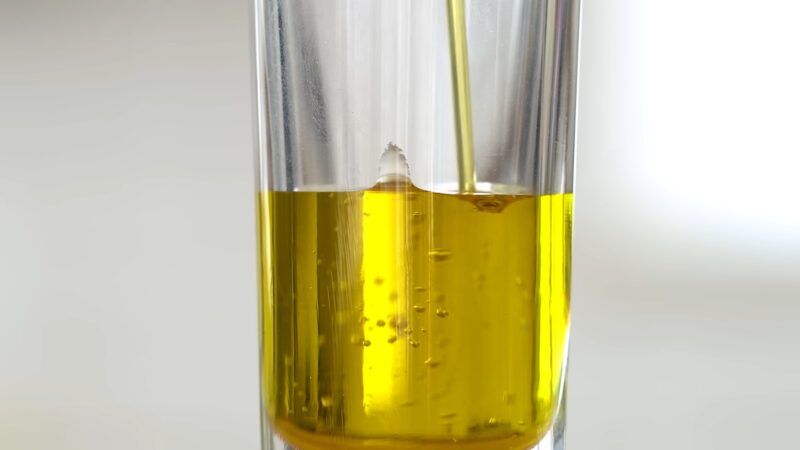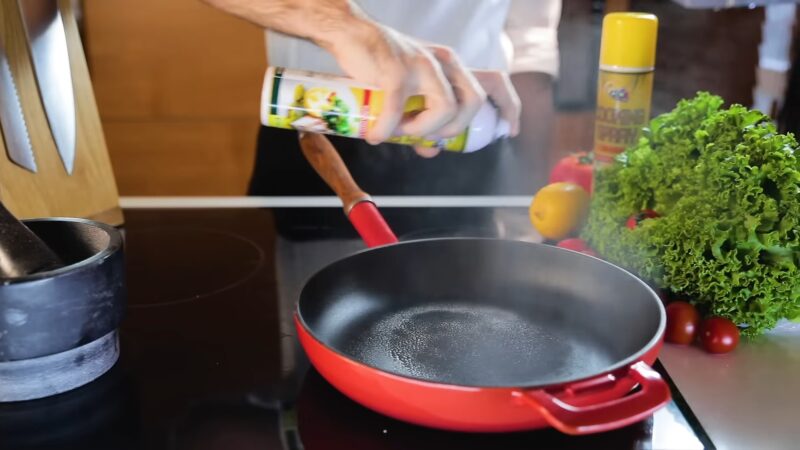The non-stick cooking spray has earned its place in the kitchen due to its convenience and ability to create perfectly cooked meals. However, the moment of reaching for the can and finding it empty is all too familiar.
Moreover, growing concerns about the chemicals in commercial aerosol sprays have led many to seek healthier, more natural alternatives. This comprehensive guide will introduce you to the best substitutes for non-stick cooking spray, ensuring your culinary masterpieces never suffer from unwanted stickiness.
We’ll explore each substitute in detail, discussing their advantages, drawbacks, effective usage, and ideal dish pairings. This guide is designed to benefit both seasoned chefs and home cooks alike, offering valuable insights to enhance your cooking journey.
Join us as we uncover the versatility of our kitchens and the potential treasures within our pantries. Get ready for a revelation as we unveil our top picks for the best substitutes for non-stick cooking spray.
1. Vegetable Oil

The Basics
Vegetable oil, a staple in most kitchens, is a versatile and accessible substitute for non-stick cooking spray. Derived from various plants, including corn, sunflower, and canola, vegetable oil is rich in polyunsaturated fats.
These fats are known for their heart-healthy benefits, making vegetable oil a nutritious choice. Its neutral flavor is another advantage, ensuring that it doesn’t interfere with or alter the taste of your dishes.
How to Use
Using vegetable oil as a non-stick cooking spray substitute is straightforward. Pour a small amount into your pan, ensuring it covers the entire surface. A pastry brush can be particularly useful for this, helping to spread the oil evenly across the pan.
This creates a non-stick surface that’s similar to what you’d achieve with a cooking spray. It’s also worth noting that vegetable oil is excellent for high-heat cooking methods, such as frying or sautéing, due to its high smoke point.
Pros and Cons
Pros:
- Vegetable oil is readily available in most kitchens, making it a convenient substitute.
- It has a high smoke point, which means it can handle high cooking temperatures without breaking down and producing harmful compounds.
- Its neutral flavor ensures it won’t interfere with the taste of your dishes.
Cons:
- While it’s a versatile cooking medium, vegetable oil doesn’t contribute any additional flavor to dishes. For recipes where a hint of extra flavor could elevate the dish, other oils might be a better choice.
- While vegetable oil is a healthier option, it’s still high in calories, so it should be used in moderation.
2. DIY Non-Stick Spray
The Basics
For those who enjoy a hands-on approach in the kitchen, creating your own non-stick cooking spray at home is a viable option. This DIY method allows you to know exactly what’s going into your spray, eliminating any concerns about potential additives or chemicals found in commercial products. All you need is a spray bottle, your preferred cooking oil, and some water.
How to Use
The process of making your own non-stick cooking spray is simple. Fill your spray bottle, which you can create on your own, with one part oil to five parts water. This ratio ensures a fine mist, similar to what you’d get from a store-bought spray. Before each use, shake the bottle well to mix the oil and water, as they tend to separate. Spray it on your pan or baking dish as needed, just as you would with a commercial cooking spray.
Pros and Cons
Pros:
- Making your own cooking spray allows you to control the ingredients, ensuring there are no unwanted additives or chemicals.
- It’s a cost-effective solution. Buying a large bottle of your preferred oil and a reusable spray bottle can be cheaper in the long run than continually buying cans of non-stick spray.
- It’s an environmentally friendly option as it reduces waste from disposable aerosol cans.
Cons:
- It requires more effort than simply buying a can of non-stick cooking spray. You need to make the mixture and clean the spray bottle regularly to prevent clogs.
- The spray might not be as effective as commercial products. The oil and water can separate, requiring you to shake the bottle before each use. Also, it might not create as fine a mist as store-bought sprays.
3. Lard

The Basics
Lard, a traditional cooking fat derived from pig fat, has been a cornerstone in cooking for centuries. Despite being overshadowed by vegetable oils in recent decades due to health concerns, lard is making a comeback in many kitchens. It’s prized for its rich, savory flavor that can significantly enhance the taste of your dishes, from pastries to fried foods.
How to Use
Using lard as a substitute for non-stick cooking spray is straightforward. Simply scoop out a small amount and let it melt in your pan before adding your ingredients. The melted lard will create a non-stick surface, preventing your food from sticking to the pan.
Pros and Cons
Pros:
- Lard adds a rich, savory flavor to dishes that other cooking fats can’t replicate.
- It’s perfect for frying, sautéing, and baking, thanks to its high smoke point and unique texture.
Cons:
- Lard is high in saturated fats, which, while not as harmful as once thought, should still be consumed in moderation as part of a balanced diet.
- It might not be suitable for vegetarian, vegan, or kosher diets due to its animal origins.
In conclusion, lard is a flavorful and versatile substitute for non-stick cooking spray. While it does have some drawbacks, such as its high saturated fat content and unsuitability for certain diets, its unique culinary benefits make it a worthy consideration for your cooking needs.
4. Butter

The Basics
Butter, a beloved ingredient in countless recipes, is an excellent substitute for non-stick cooking spray. Made from churned cream or milk, butter is celebrated for its rich, creamy flavor that can elevate your dishes to new culinary heights. In addition to its flavor-enhancing properties, butter also contributes to a beautiful, golden crust on baked goods, making it a favorite among bakers.
How to Use
Using butter as a substitute for non-stick cooking spray is simple. Cut a small piece of butter and let it melt in your pan over low heat before adding your ingredients. For baking, you can soften the butter and spread it over your baking dish using a pastry brush. The melted or softened butter will create a non-stick surface, preventing your food from sticking to the pan or dish.
Pros and Cons
Pros:
- Butter adds a rich, creamy flavor to dishes that other cooking fats can’t replicate.
- It’s perfect for baking, frying, and sautéing, thanks to its unique texture and flavor-enhancing properties.
Cons:
- Butter is high in saturated fats, which, while not as harmful as once thought, should still be consumed in moderation as part of a balanced diet.
- It has a lower smoke point compared to other fats, which means it can burn if the heat is too high.
5. Avocado Oil

The Basics
Avocado oil is a heart-healthy alternative to non-stick cooking spray that’s gaining popularity in modern kitchens. Extracted from the pulp of avocados, this oil is rich in monounsaturated fats, known for its heart-healthy benefits. One of its standout features is its exceptionally high smoke point, making it an excellent choice for high-heat cooking methods like frying or sautéing.
How to Use
Using avocado oil as a substitute for non-stick cooking spray is straightforward. Pour a small amount into your pan or baking dish and use a pastry brush or paper towel to spread it evenly, creating a non-stick surface. Its high smoke point makes it perfect for high-heat cooking methods, and its neutral flavor ensures it won’t interfere with the taste of your dishes.
Pros and Cons
Pros:
- Avocado oil has a high smoke point, making it suitable for high-temperature cooking.
- It has a neutral flavor that won’t interfere with the taste of your dishes.
- It’s packed with heart-healthy monounsaturated fats and other beneficial nutrients.
Cons:
- Avocado oil is more expensive than other cooking oils, which might make it a less appealing option for some.
- It’s not as widely available as other oils, such as vegetable or olive oil.
- Most of the brands available on the market are rancid or impure
Final Words
In conclusion, non-stick cooking isn’t confined to commercial sprays. With options ranging from vegetable oil and lard to homemade sprays and avocado oil, the alternatives are diverse and plentiful.
Each has unique benefits and potential drawbacks, and the best choice depends on your cooking needs and health preferences. So, when your non-stick spray runs out, don’t worry. Your pantry may hold a superior substitute. Here’s to healthier, tastier, and more creative cooking adventures!

